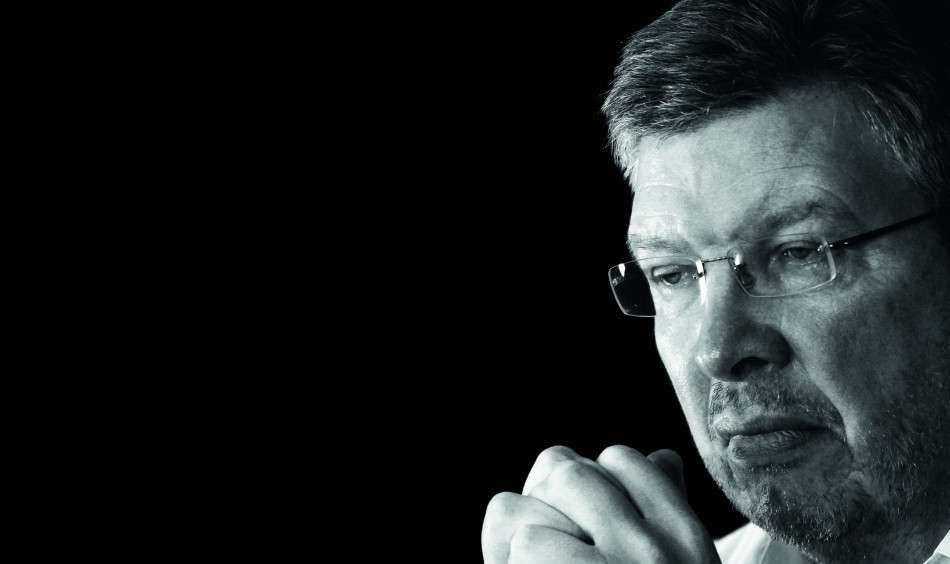From Auto #17: Reading the rules
Interpreting the new regulations and making them work for your team is key to success in Formula One – and it’s something Ross Brawn was a master at, as he explains to AUTO

Click here to read the full AUTO #17 issue online.
During your Formula One career you experienced several sets of major regulation changes. What’s the key to maximising the opportunity large-scale changes represent?
I think the first thing is to be active in trying to shape those regulation changes because the discussions are always inclusive, unless it’s a safety issue where you tend to find decisions are understandably made for you.
Normally if there’s a significant regulation change what happens is the FIA, sometimes in combination with the commercial rights holder, will say, ‘We’ve got to make some changes here because we feel Formula One is going in the wrong direction,’ for any number of reasons. In the past, that decision was handed down to the various working groups, which were then asked to come forward with proposals. I was active in those working groups, and being involved with defining regulations from an early stage you start to understand what’s trying to be achieved and what the priorities are.
Is that process defined by where your team wants the regulations to go, or by the greater good of the sport? How impartial can a team be in helping to formulate regulations?
I can honestly say that in that early gestation period of the regulations I was focused totally on trying to achieve the objectives that we’d been set, because at that stage no one’s got an advantage or disadvantage really. As long as the regulations are in two or three years’ time, then you can take a position that is impartial to your team perspective and look at what’s good for F1.
Where it becomes sensitive to your team is the next year, when you feel that possibly you’re being disadvantaged, in which case you then get quite strong in your views of what should or shouldn’t happen.
If you’re given the opportunity and say, ‘In two years’ time we want to achieve these objectives, what’s the best way?’, then you can work impartially to try and achieve those objectives.
So I was always very active in making sure I was part of that process. When that process is complete then you’ve got fine-tuning of the regulations where interpretations start to come into it and you have to clarify the regulations around the interpretations. Once those regulations are firm enough, you start to put the teams together to build the cars or the engines, or decide what you’re going to do.
How Machiavellian do you have to become when it comes down to that fine detail?
You do get competitive, inevitably. Once you’ve started your programme, once you’ve started putting your teams together, you want to steer it in a certain direction because you’re committing to a certain path.
If you have an interpretation of a regulation that you feel is going to give you a competitive advantage then you want to try to maintain that. That’s where politicking and other elements can come in.
I always had a clear conscience on that because if I started the process in a completely impartial way, once we’d passed that gate, then I had to put my other hat on and say, ‘Now I’m working just for the team. I’ve got to find the best solutions for my team around those regulations.’ Some would argue, and I understand it, that you can never separate the two completely, but I think I made a fair attempt.
To take a global view and then narrow the focus?
Exactly. But once you get into the application of the regulations for your team, then you defend your corner in order to get all the advantages you can.
The other interesting thing about the process, if you start early enough, if you’re the first team to query interpretations with the FIA, is that then you have an advantage because you can start to shape the arguments.
Being early in that process was important and we found that with the engine when I was at Mercedes. We’d started the engine project very early. With the queries we were making to the FIA for clarifications, it was clear that we were the first ones to do that, so we could start to debate various elements of it. It also gave us some encouragement because we knew no one else was ahead of us.
It is an involved process. What I’d always do was put a small team onto the project early on, because they open up areas where you start to understand what sort of team you need to build to implement the changes properly.
The 2017 technical regulations were locked down in February 2016, so what would be the normal procedure at a team following ratification?
My approach was to devote research to it and make that sacrosanct, because in the cut and thrust of normal F1, it’s too easy for that resource to get moved into day-to-day dramas, and then you put it back on the project a week or two later and suddenly you’ve lost that time and you can’t recreate it.
My practice was to set up a team, identify what was needed to get the project running properly and say: ‘Right, there’s a small project team. I want to know what’s going on, but otherwise we’re not going to touch them.’
You say it’s easy to get lost in the day-to-day competition. How difficult is it to resist that, particularly if you’re racing for a championship? Did you ever have to say, ‘We’re going to sacrifice this because I’ve got to take a longer-term view?’
I did, and I think that happened in 2013, my last year in F1. Up until the summer break, we were fighting with Red Bull for the championship, but I had a programme where resources were being moved across to the 2014 programme.
My judgement now is that Red Bull didn’t do that because they came back after the summer break with a car that was a lot faster, so they must have kept an effort going on that existing car or else they had more resources than we had! However, the consequence of that was that they began 2014 on the back foot. Having the opportunity and the conviction to make the call [on which fights you pick] is essential.
It is a tough call to make, especially if you are beholden to masters who may be impatient to see a competitive return on their investment. You get confidence from the experience of seeing it happen in the past and saying to yourself, ‘Look, slim chance of winning the title this year. Do we really want to throw everything at it, or should we keep our strength of conviction and head for the future?’ The future should win.
Was there a temptation in 2013 to turn to the Mercedes board and simply say ‘Just give us more money’?
You can’t turn it on that quickly, unfortunately. There’s an inertia in these systems and if you decide you want to add to them, it’s a six-month programme.
Mercedes’ 2014 success was actually born at the end of 2011, 2012 when we had a tough meeting with the board. They were either going to stop or they were going to step up, because 2010 and ‘11 weren’t good enough. We had been following the resource restriction philosophy, which was collapsing. We were 450 people and we were fighting teams that were 500 or 600 people, and there’s no solution to that.
We said to the board: ‘Either we step up or we ought to step back because we’re in between at the moment.’ The board, all credit to them, said: ‘OK, we’ll step up. We’ll give it a go. What do you need?’
So it was then that we put the project teams together for 2014. We hired Aldo Costa. We hired Geoff Willis. We hired the people we needed and it started to come together. That’s the strategic planning you need. You’ve got to have a vision of where you want to be in six, 12 months, a year, two years.
In the heat of battle, and under pressure from a paymaster to achieve, that’s often hard to implement. Some would say it’s a problem affecting your other team, Ferrari, at the moment. Is that your view?
It looks that way from the outside, and I think they’ve got to get the stability back and get the confidence back to start building their programmes.
It’s always difficult to stabilise in the short term while then building for the long term, but if everything is a knee-jerk reaction, you never get out of it. You might find a quick solution but you get caught in this vicious cycle of short-term response and reaction. You never take your focus off that so what you should be doing over here, getting good programmes established, which are then feeding into your race programme, never happens.
Once you’ve done the research on new regulations, once the project teams bring back their initial findings, someone has to make a call on a direction to take. Was that you?
I describe myself as a friendly dictator. What I wanted was a group e ort because then you harness all the power and resource. But yes, eventually someone has to make a decision as to what direction you go in and I was happy to do that. But I wanted everyone to sign up to it as well. So my quid pro quo was: I’m going to make the decision but you are going to be part of the team that will enable me to make the best decision I can. Therefore, as you are part of the team maybe that decision is not quite what you thought it should be, but you are going to commit to it because you had your opportunity to feed into it.
In most cases it was rare that there was one big decision to make, it would be more a case of saying, ‘I can see that they need more resource there, I’ll stick some more people on that’ or that they might come to me and say, ‘Look, we’re not clear on whether we can take this interpretation or not, what should we do?’ I would give them my opinion and it might get to the point that I would go to the FIA and debate and discuss it.
I did less of that in later years, because me getting involved usually meant there was a big issue! I’d play devil’s advocate, coach the people involved on how they should approach it and then send them off to have a debate with the FIA.
There was a pretty structured approach to all those things with project teams, objectives set, timings agreed. I would hold their feet against the fire if they weren’t moving along well enough and I’d move resource around when it was needed. It was, I thought, a pretty proper structure to achieve goals.
Also, I think you waste resource if you run parallel programmes where you then try to decide at the end what is best. You might decide to pursue a couple of different ideas to see what proves to be the best solution, but I would expect those teams to work collectively on those ideas.
What do you think of this set of regulations?
I’ve not been involved in the process to generate these regulations. When you are involved you know them intimately. I’ve read this set broadly and they’re a big step in a certain direction. Outwardly they should make the cars a lot quicker. They’ll look racy, with wider track, wider tyres, and the way the wings are profiled the cars are going to look pretty exciting.
It will be fascinating, though, as it’s putting the emphasis back on the chassis. There is a view that it was too much towards the engine, but actually I think it brought some balance. We went through a phase where the influence of the engine was almost neutral because everything was frozen and they were almost just a bracket between the gearbox and the chassis, whereas now people talk about the engines.
The engine-orientated regulations led to Mercedes dominating, so will the 2017 rules upset the pecking order?
Mercedes will have been pulling resource off this year’s programme onto next year very early, once they saw where they were with the car. If I was there, and I’m sure they’ve carried on a similar philosophy, I’d be saying, ‘Right, we’ve got a strong car, we can only beat ourselves, let’s get everyone onto next year’s programme’. I don’t know how many other teams could do that. Success breeds success. Mercedes will be strong next year, despite the greater emphasis on chassis.
The next hurdle comes in 2020 with a decision needed on the future of engines. How do you think F1 should progress?
F1 has to take a hard look at what it wants from an engine. What we’ve done in the last few years is align ourselves with road cars. We’ve got this revolution going on, and the road cars we’ll have in five to 10 years’ time are going to be very different.
Can we maintain the technological marvel of F1 but acknowledge that perhaps now is the time to start diverging from where road cars are going? If we don’t, logic says we should have electric or fuel-cell F1 cars in a few years’ time. We have Formula E and that’s establishing its place, but for me F1 isn’t just a technological demonstration, it’s a whole circus, and what’s the best way of maintaining that? It might be time to say, ‘We’ve had this technological marvel, but we’re going to step back and think about what F1 ideally wants from an engine, which may have to contain some technologies that are relevant.’ We have to sit down with the manufacturers, teams and interested parties and decide what we want beyond 2020. Maybe it’s what we’ve got now but refined in terms of cost and complexity, because the engine is too expensive.
In some ways the current engine is a technological marvel and it did re-engage the manufacturers, but if F1 starts to look at 2020 now there’s time to do it without anyone feeling any competitive disadvantage, with the investments and plans being made correctly. You need two years to sort an engine out. By the end of next year, Formula One needs to know what sort of engine it needs for the future.


 Facebook
Facebook Twitter
Twitter






